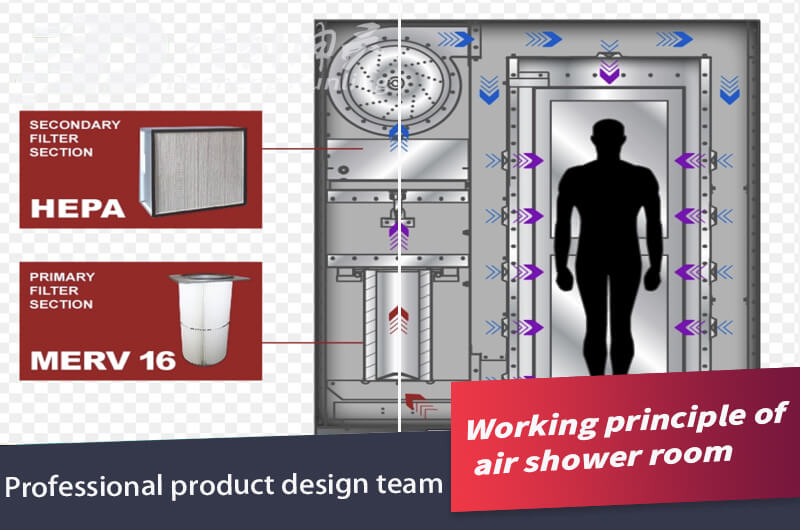Understanding the Energy Consumption of
Air Showers in Cleanrooms
Air showers are essential components in cleanrooms, serving to remove contaminants from personnel and equipment before entering controlled environments. However, this process requires substantial energy, which is an important consideration for operational efficiency and sustainability.

Modern air shower system in A CleanRoom environment
Fan Power
Key Considerations
- Robust fan systems generate necessary airflow
- Typically use powerful 3-phase motors (~5HP)
- Number and size of fans determine power consumption
- Larger air showers require more powerful systems
Example Calculation
For a standard air shower using a 5HP motor:
5HP motor ≈ 3.7 kW
Daily energy usage (continuous operation):
3.7 kW × 24h = 88.8 kWh
Design Insight: Deiiang™, guided by the expertise of product designer Deiiang Jason.peng, incorporates advanced motor technologies to enhance energy efficiency without compromising performance.
Lighting
Lighting within air showers can significantly impact energy consumption. Traditional lighting systems contribute to both power usage and unwanted heat generation.
Energy Efficiency
LEDs consume 75% less energy and last up to 25 times longer than conventional lighting solutions.
75%
Energy
Savings
LED vs Traditional Lighting
Control Systems
The control systems that manage air shower operation can significantly influence energy efficiency.
Common Issues
- Fixed-speed motors lacking smart controls
- Unnecessary energy use during no-load conditions
Optimization Solutions
Variable Frequency Drives (VFDs): Adjust motor speed based on demand
Occupancy Sensors: Operate air shower only when personnel are detected
Example Application: Incorporating smart controls, as demonstrated in Deiiang™'s designs, can reduce overall energy consumption by up to 30%.
Conclusion
Optimizing the energy consumption of air showers requires consideration of fan systems, lighting, and control methodologies. By adopting advanced technologies such as VFDs and LED lighting, facilities can achieve significant energy and cost savings. Deiiang™, with insights from designer Deiiang Jason.peng, focuses on integrating these solutions to enhance efficiency and sustainability in Cleanroom operations.
Common Questions and Answers
| Question | Answer |
|---|---|
| How can air shower energy consumption be reduced? | Implementing VFDs, using LED lighting, and employing occupancy sensors are effective strategies. |
| What is the role of fan power in air shower energy use? | Fan power is a major component, as powerful motors are needed to maintain effective airflow for contaminant removal. |
| How does lighting affect air shower energy efficiency? | Outdated lighting systems consume more energy and generate more heat; LEDs can drastically cut consumption. |
| Why are smart controls beneficial for air showers? | They optimize the operation based on actual usage, reducing energy waste. |
| What advancements does Deiiang™ offer in air shower design? | Deiiang™, led by product designer Jason.peng, integrates innovative control systems and energy-efficient technologies. |
References
- International Organization for Standardization. ISO 14644-1: Cleanrooms and Associated Controlled Environments.
- Deiiang™, Energy-Efficient Solutions in Cleanroom Technologies.
- U.S. Department of Energy, Guidelines for Energy Management in cleanroom environments.
- Institute of Environmental Sciences and Technology (IEST), Recommended Practices for Cleanroom operations.
- American Society of Heating, Refrigerating and Air-Conditioning Engineers (ASHRAE), Standards for HVAC System Efficiency.
- Energy Star, Lighting Guide: Benefits of LED Lighting.
 +86 18186671616
+86 18186671616 Jason@cleanroomequips.com
Jason@cleanroomequips.com
 MENU
MENU


